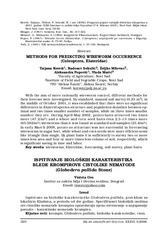Приказ основних података о документу
Study of the pale potato cyst nematode biological characteristics (Globodera pallida Stone)
Ispitivanje bioloških karakteristika blede krompirove cistolike nematode (Globodera pallida Stone)
| dc.creator | Oro, Violeta | |
| dc.date.accessioned | 2019-04-04T15:52:03Z | |
| dc.date.available | 2019-04-04T15:52:03Z | |
| dc.date.issued | 2008 | |
| dc.identifier.issn | 0354-6160 | |
| dc.identifier.uri | https://plantarum.izbis.bg.ac.rs/handle/123456789/64 | |
| dc.description.abstract | Biological characteristics of Globodera pallida, originating from Kladnica locality, have been studied. The biological cycle of G. pallida begins with egg stage. Eggs are inside the cyst, protected from outside influence and long-lived. In the process of juvenile morphogenesis, egg transforms from undifferentiated cell mass to juvenile of first stage (J1), which is immobile and non-feeding. The first stage juvenile undergoes one molt to form second one juvenile (J2). The second stage juvenile leaves the egg and start searching for potato root cell appropriate for invasion. Root penetration is enabled with stylet and with help of numerous degradable enzymes from esophageal glands. After invasion, J2 stops moving, becomes sedentary and the feeding site becomes a metabolic reservoir-syncytium. The second stage juvenile undergoes three molts there and transforms to juvenile of third (J3) and fourth ones (J4). After the last molt, J4 becomes either male which leaves tissue and searches for young female or preadult female, swollen and pear like. During maturation, preadult female becomes more swollen and makes pressure on the surrounding tissue, so it ruptures showing the most of the body together with perineal pattern of the female. After mating male dies and female becomes cyst with eggs and juveniles. After some time, females also die changing the color to dark brown or black. Biological characteristics specificities of the pale potato cyst nematode such as: high economical loss in the potato production, numerous eggs and juveniles as infective material, specific biological cycle, which protects the parasites inside the tissue. Then, degradable enzymes production, the shape and size of cysts for easy dissemination, cryptic coloration of cysts, resistance to outside influence and high longevity justify its classification into the group of the most significant parasites - the quarantine potato nematodes. | en |
| dc.description.abstract | Ispitivane su biološke karakteristike Globodera pallida, poreklom sa lokaliteta Kladnica, u periodu od dve godine. Specifičnosti bioloških osobina ove cistolike nematode krompira opravdavaju njeno svrstavanje u najopasnije parazite - karantinske nematode krompira. | sr |
| dc.publisher | Poljoprivredni fakultet - Departman za zaštitu bilja i životne sredine "dr Pavla Vukasovića", Novi Sad | |
| dc.rights | openAccess | |
| dc.source | Biljni lekar | |
| dc.subject | potato | en |
| dc.subject | Globodera pallida | en |
| dc.subject | biological characteristics | en |
| dc.subject | cyst | en |
| dc.subject | krompir | sr |
| dc.subject | Globodera pallida | sr |
| dc.subject | biološke karakteristike | sr |
| dc.subject | cista | sr |
| dc.title | Study of the pale potato cyst nematode biological characteristics (Globodera pallida Stone) | en |
| dc.title | Ispitivanje bioloških karakteristika blede krompirove cistolike nematode (Globodera pallida Stone) | sr |
| dc.type | article | |
| dc.rights.license | ARR | |
| dc.citation.epage | 325 | |
| dc.citation.issue | 5 | |
| dc.citation.other | 36(5): 320-325 | |
| dc.citation.spage | 320 | |
| dc.citation.volume | 36 | |
| dc.type.version | publishedVersion | |
| dc.identifier.fulltext | https://plantarum.izbis.bg.ac.rs//bitstream/id/1658/62.pdf |


